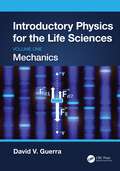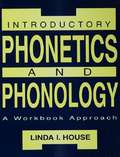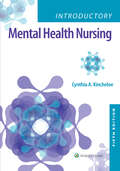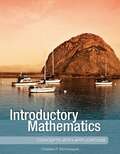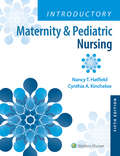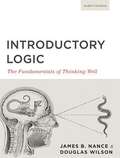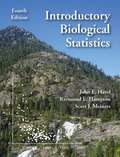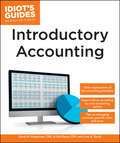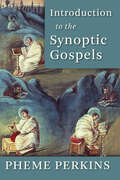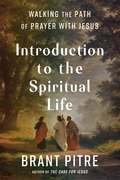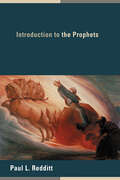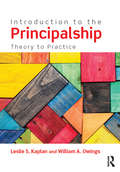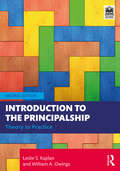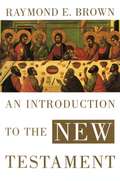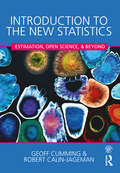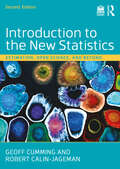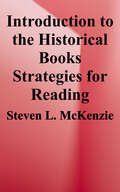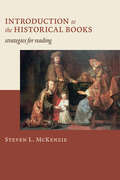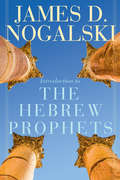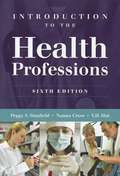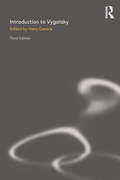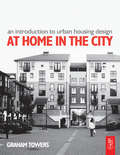- Table View
- List View
Introductory Physics for the Life Sciences: Mechanics (Volume One)
by David V. GuerraThis textbook provides an accessible introduction to physics for undergraduate students in the life sciences, including those majoring in all branches of biology, biochemistry, and psychology and students working on pre-professional programs such as pre-medical, pre-dental, and physical therapy. The text is geared for the algebra-based physics course, often named College Physics in the United States. The order of topics studied are such that most of the problems in the text can be solved with the methods of Statics or Dynamics. That is, they require a free body diagram, the application of Newton’s Laws, and any necessary kinematics. Constructing the text with a standardized problem-solving methodology, simplifies this aspect of the course and allows students to focus on the application of physics to the study of biological systems. Along the way, students apply these techniques to find the tension in a tendon, the sedimentation rate of red blood cells in haemoglobin, the torques and forces on a bacterium employing a flagellum to propel itself through a viscous fluid, and the terminal velocity of a protein moving in a Gel Electrophoresis device. This is part one of a two-volume set; volume 2 introduces students to the conserved-quantities and applies these problem-solving techniques to topics in Thermodynamics, Electrical Circuits, Optics, and Atomic and Nuclear Physics always with continued focus on biological applications. Key Features: Organised and centred around analysis techniques, not traditional Mechanics and E&M. Presents a unified approach, in a different order, meaning that the same laboratories, equipment, and demonstrations can be used when teaching the course. Demonstrates to students that the analysis and concepts they are learning are critical to the understanding of biological systems.
Introductory Phonetics and Phonology: A Workbook Approach
by Linda I. HouseSuccess in mastering any language requires knowledge in speaking, reading, and writing the language. The speaking component requires the understanding and use of correct pronunciation, emphasis, and syntactic patterns. The written component requires mastery of the alphabet, spelling, and the ability to write, print, or type the pattern. Very early in the learning process, speakers of the English language become keenly aware of the language's lack of sound to symbol correspondence. To help speech/language researchers, media personnel, individuals learning English as a second language, and others interested in correct pronunciation, the International Phonetic Alphabet (IPA) was devised. Extensively class tested, this book offers a practical understanding approach to phonetics and the IPA in a workbook format. It will be welcomed by professionals, students, and trainees in the fields of communication science, communication disorders, speech pathology, and linguistics.
Introductory Mental Health Nursing
by Cynthia A. KincheloeUpdated, easy to read, and designed specifically for today’s LPN/LVN students, Introductory Mental Health Nursing, 5th Edition, makes the realities of mental health nursing approachable and prepares students to confidently manage clients’ mental healthcare needs across a wide range of care settings. This extensively revised 5th Edition delivers clear, comprehensive, clinically relevant information reflecting the care needs of a diverse client population. Powerful built-in study aids strengthen students’ critical thinking and clinical application capabilities to prepare them for any challenge they may encounter.
Introductory Mathematics: Concepts with Applications
by Charles P. McKeague"This textbook provides students with a solid foundation in basic mathematics, and an excellent preparation for algebra. The format, examples, and problems in this book have been refined through more than 20 years of classroom testing. As with all McKeague titles, his emphasis on study skills and his positive tone toward success are reflected in the presentation."
Introductory Maternity and Pediatric Nursing
by Cynthia Kincheloe Nancy HatfieldPrepare today’s LPN/LVN students for success on the NCLEX-PN® and in clinical practice with this proven introduction to the essentials of maternity and pediatric nursing. Designed specifically for the LPN curriculum, Introductory Maternity and Pediatric Nursing, 5th Edition, focuses on need-to-know coverage of pregnancy, birth, and pediatrics, combining a clear, straightforward approach with built-in workbook features that reinforce understanding without the need for an additional study guide. Accompanied by engaging online resources, this up-to-date learning package provides the ideal foundation for your students’ success in LPN/LVN practice.
Introductory Macro Economics class 12 - CBSE Board
by Sandeep GargSalient Features of the Book: Each topic has been written in accordance with the latest guidelines issued by CBSE, The concepts have been systematically explained through use of diagrams, tables and examples, HOTS Questions with answers have been given at the end of each chapter to enhance the student’s understanding, analytical ability and interpretation, Multiple Choice Questions (MCQs) with answers have been given at the end of each chapter, Each chapter contains True and False Questions and NCERT textbook questions (with hints), Value Based Questions with answers have been given in the revision section, Practical Problems have the considerable weightage in the Board Examination To have a competitive edge, large number of comprehensive solved and unsolved practical problems have been given and Power Booster Section has been provided for knowledge enrichment of the students.
Introductory Logic:The Fundamentals of Thinking Well (5th Edition.)
by Douglas Wilson James B. NanceThis book intends to help students in establishing a concrete and applicable knowledge of propositional arguments.
Introductory Biological Statistics
by Scott J. Meiners Raymond E. Hampton John E. HavelCourses such as statistics, which develop quantitative analytical skills, remain important preparation for careers in the sciences and graduate school. The book supports teaching a one-semester-long course in statistics with a focus on biological examples and applications. Students need not have any prior exposure to probability and statistics, although college algebra is recommended. The book has added concept checks in all of the chapters, as well as more definition boxes and examples. A number of substantive changes has been made in this new edition. The exercises in each chapter have now been sorted into two groups: practice exercises (with solutions in appendix B) and homework exercises (solutions available only to instructors).
Introductory Accounting (Idiot's Guides)
by Lisa A. Bucki David H. Ringstrom Gail PerryAccurate accounting is the key to a successful business. But when you&’re dealing with assets and liabilities, profit and loss, and debits and credits, juggling all the numbers can quickly get confusing. Introductory Accounting gives you everything you need to know about basic financial accounting to manage your dollars and cents and keep your accounts in order. Ideal for small businesses, as well as any large company bookkeeper, this book covers:• Structuring your business and choosing an accounting method.• Setting up an accounting system and basic operating procedures (tracking sales, determining costs, managing cash, etc.).• Creating employee records, maintaining a payroll system, and accounting for benefits.• Keeping tax and benefit records.• Reporting costs.• Closing out cash journals and employee accounts at month-end and balancing ledgers.• Preparing month-end and year-end statements and reports. • Producing a balance sheet and monthly profit-and-loss (P&L) statements.• Using accounting software.
Introduction to the Synoptic Gospels
by Pheme PerkinsIn this book respected New Testament scholar Pheme Perkins delivers a clear, fresh, informed introduction to the earliest written accounts of Jesus — Matthew, Mark, and Luke — situating those canonical Gospels within the wider world of oral storytelling and literary production of the first and second centuries. Cutting through the media confusion over new Gospel finds, Perkins’s Introduction to the Synoptic Gospels presents a balanced, responsible look at how the Gospels of Matthew, Mark, and Luke came to be and what they mean.
Introduction to the Spiritual Life: Walking the Path of Prayer with Jesus
by Brant PitreA compelling exploration of the biblical foundations, contemplative practices, and spiritual path of Jesus himself—from the bestselling author of The Case for Jesus&“What happens when a biblical theologian explores classic spirituality? This book. Pitre&’s students have asked, Why have we never heard this before? The reader wonders the same.&”—Dr. David Fagerberg, author of Liturgical Mysticism The path of following Jesus is an ancient and storied spiritual tradition. Yet many believers are not familiar with the three major forms of prayer and the three stages of spiritual growth that exist to bring them closer to God.In his most personal book yet, Dr. Brant Pitre draws on the riches of the Bible, the words of Jesus, and the writings of mystics across the centuries to shed light on the mystery—and wonder—of the spiritual life.Starting with the age-old belief that the path of prayer is not only informative but transformative, Dr. Pitre explores• the scriptural roots of vocal, meditative, and contemplative prayer• the purgative, illuminative, and unitive stages of spiritual growth• the spiritual exercises of prayer, fasting, and almsgiving• the Jewish roots of the Lord&’s Prayer• Lectio Divina: how to pray with the Bible• seven vices and their seven opposing virtues• the battle of prayer: how to deal with difficulty and distractions• the &“dark night of the soul&” in the ScripturesFull of sacred truths, contemplative insights, and practical steps, Introduction to the Spiritual Life is a veritable biblical road map of the spiritual landscape that enables us to follow Jesus as our primary guide.
Introduction to the Prophets
by Paul L. ReddittWriting in a conversational rather than a scholarly tone, Paul Redditt assumes little or no prior knowledge of the Old Testament as he presents and introduces the Major and Minor Prophets in the canonical order of the English Bible. The chapters of Redditt's Introduction to the Prophets discuss the place of each book in the canon; the literary setting of each book; their structure, integrity, and authorship; the main genre(s) in each; special features of each book; basic emphases of each book; and problems -- theological, literary, or historical -- raised by a study of the book. Among other things, Redditt demonstrates that the prophets were both &“foretellers&” and &“forthtellers,&” and he argues that the Old Testament prophets developed the concept of monotheism. Each chapter ends with questions for further reflection. Concluding the volume are a helpful glossary and several indexes.
Introduction to the Principalship: Theory to Practice
by Leslie S. Kaplan William A. OwingsThe latest leadership textbook from respected author team Kaplan and Owings explores how principals can effectively build a culture around student achievement. Introduction to the Principalship helps aspiring principals understand how to develop a vision for improvement, make decisions and manage conflict, build teachers’ capacity, communicate, monitor the organization’s performance, and create a school climate of mutual respect. This important book provides readers with various leadership concepts to inform their practice, as well as the cognitive and practical tools to evaluate and prioritize what leadership actions to take. Each chapter offers opportunities for readers to create personal meaning and explore new ways of doing leadership to advance a positive, person-focused environment. Providing both the theoretical framework and skills for effective practice, Introduction to the Principalship addresses the issues most urgent and relevant for educational leadership graduate students learning how to build a school culture that promotes every student’s success. Special Features: • Learning Objectives—chapter openers introduce the topic and initiate student thinking.• Reflections and Relevance —interactive exercises, role plays, class activities, and assignments help readers think about content in personally meaningful ways, facilitate understanding of chapter content, and help transfer leadership thinking to action in their own schools.• ISLLC Standards—each chapter is aligned to the 2015 Interstate School Leadership Licensure Standards.• Companion Website—includes links to supplemental material, additional readings, and PowerPoints for instructors.
Introduction to the Principalship: Theory to Practice
by Leslie S. Kaplan William A. OwingsThe second edition of this textbook from respected author team Kaplan and Owings explores how principals can effectively build a culture around student achievement. Introduction to the Principalship, a second edition closely aligned with NELP (2018) standards, helps aspiring principals understand how to develop a vision for improvement, make decisions and manage conflict, build teachers’ capacity, communicate, monitor the organization’s performance, and create a school climate of mutual respect. This important book provides readers with various leadership concepts to inform their practice, as well as the cognitive and practical tools to evaluate and prioritize what leadership actions to take. Each chapter offers opportunities for readers to create personal meaning and explore new ways of doing leadership to advance a positive, person-focused environment. Providing both the theoretical framework and skills for effective practice, Introduction to the Principalship addresses the issues most urgent and relevant for educational leadership graduate students learning how to build a school culture that promotes every student’s success. Fully revised, this second edition includes a new chapter on building your capacity for leadership, expanded discussion of data-informed accountability, equity considerations, and crisis management, and all chapters updated and revised throughout to reflect the latest developments in the field. Special Features: •Learning Objectives—chapter openers introduce the topic and initiate student thinking. •Reflections and Relevance—interactive exercises, role plays, class activities, and assignments that can be used synchronously and asynchronously to deepen and extend student learning. •Key Takeaways—organized by learning objective, these answer readers’ question, "What about this information is meaningful for me as an aspiring principal?" •Suggested Readings—each chapter concludes with annotated suggested readings to extend and deepen discussion of key issues in chapter. •NELP Standards—each chapter is aligned to the latest school leadership licensure standards. •Companion Website—includes links to supplemental material, additional readings, video clips with related teaching and learning activities, and PowerPoints for instructors.
Introduction to the Principalship: Theory to Practice
by Leslie S. Kaplan William A. OwingsThe second edition of this textbook from respected author team Kaplan and Owings explores how principals can effectively build a culture around student achievement. Introduction to the Principalship, a second edition closely aligned with NELP (2018) standards, helps aspiring principals understand how to develop a vision for improvement, make decisions and manage conflict, build teachers’ capacity, communicate, monitor the organization’s performance, and create a school climate of mutual respect. This important book provides readers with various leadership concepts to inform their practice, as well as the cognitive and practical tools to evaluate and prioritize what leadership actions to take. Each chapter offers opportunities for readers to create personal meaning and explore new ways of doing leadership to advance a positive, person-focused environment. Providing both the theoretical framework and skills for effective practice, Introduction to the Principalship addresses the issues most urgent and relevant for educational leadership graduate students learning how to build a school culture that promotes every student’s success.Fully revised, this second edition includes a new chapter on building your capacity for leadership, expanded discussion of data-informed accountability, equity considerations, and crisis management, and all chapters updated and revised throughout to reflect the latest developments in the field.Special Features: Learning Objectives - chapter openers introduce the topic and initiate student thinking Reflections and Relevance - interactive exercises, role plays, class activities, and assignments that can be used synchronously and asynchronously to deepen and extend student learning Key Takeaways - organized by learning objective, these answer readers’ question, "What about this information is meaningful for me as an aspiring principal?" Suggested Readings - each chapter concludes with annotated suggested readings to extend and deepen discussion of key issues in chapter NELP Standards - each chapter is aligned to the latest school leadership licensure standards Companion Website - includes links to supplemental material, additional readings, video clips with related teaching and learning activities, and PowerPoints for instructors.
Introduction to the New Testament
by Raymond E. BrownEvery generation needs a comprehensive, reliable Introduction to the New Testament that opens the biblical text to the novice. Raymond E. Brown's An Introduction to the New Testament is the most trustworthy and authoritative guidebook for a generation seeking to understand the Christian Bible. Universally acknowledged as the dean of New Testament scholarship, Father Brown is a master of his discipline at the pinnacle of his career. Who else could cover the entire scope of the New Testament with such ease and clarity? This gifted communicator conveys the heartfelt concern of a beloved teacher for his students, as he walks the reader through the basic content and issues of the New Testament. While the book contains a wealth of information, its most impressive features are how the author boils down a life time of scholarship into basic summaries of each book, provides a historical overview of the ancient Greco-Roman world, engages in discussions of theological issues, and presents supplementary material for deeper understanding, such as tables, maps, bibliographies, and appendixes. Those opening to the New Testament for the first time and those seeking deeper insights could not ask for more in a primer to the Christian Bible.
Introduction to the New Statistics: Estimation, Open Science, and Beyond
by Geoff Cumming Robert Calin-JagemanThis is the first introductory statistics text to use an estimation approach from the start to help readers understand effect sizes, confidence intervals (CIs), and meta-analysis (‘the new statistics’). It is also the first text to explain the new and exciting Open Science practices, which encourage replication and enhance the trustworthiness of research. In addition, the book explains NHST fully so students can understand published research. Numerous real research examples are used throughout. The book uses today’s most effective learning strategies and promotes critical thinking, comprehension, and retention, to deepen users’ understanding of statistics and modern research methods. The free ESCI (Exploratory Software for Confidence Intervals) software makes concepts visually vivid, and provides calculation and graphing facilities. The book can be used with or without ESCI. Other highlights include: - Coverage of both estimation and NHST approaches, and how to easily translate between the two. - Some exercises use ESCI to analyze data and create graphs including CIs, for best understanding of estimation methods. -Videos of the authors describing key concepts and demonstrating use of ESCI provide an engaging learning tool for traditional or flipped classrooms. -In-chapter exercises and quizzes with related commentary allow students to learn by doing, and to monitor their progress. -End-of-chapter exercises and commentary, many using real data, give practice for using the new statistics to analyze data, as well as for applying research judgment in realistic contexts. -Don’t fool yourself tips help students avoid common errors. -Red Flags highlight the meaning of "significance" and what p values actually mean. -Chapter outlines, defined key terms, sidebars of key points, and summarized take-home messages provide a study tool at exam time. -http://www.routledge.com/cw/cumming offers for students: ESCI downloads; data sets; key term flashcards; tips for using SPSS for analyzing data; and videos. For instructors it offers: tips for teaching the new statistics and Open Science; additional homework exercises; assessment items; answer keys for homework and assessment items; and downloadable text images; and PowerPoint lecture slides. Intended for introduction to statistics, data analysis, or quantitative methods courses in psychology, education, and other social and health sciences, researchers interested in understanding the new statistics will also appreciate this book. No familiarity with introductory statistics is assumed.
Introduction to the New Statistics: Estimation, Open Science, and Beyond
by Geoff Cumming Robert Calin-JagemanThis fully revised and updated second edition is an essential introduction to inferential statistics. It is the first introductory statistics text to use an estimation approach from the start and also to explain the new and exciting Open Science practices, which encourage replication and enhance the trustworthiness of research. The estimation approach, with meta-analysis (“the new statistics”), is exactly what’s needed for Open Science.Key features of this new edition include: Even greater prominence for Open Science throughout the book. Students easily understand basic Open Science practices and are guided to use them in their own work. There is discussion of the latest developments now being widely adopted across science and medicine. Integration of new open-source esci (Estimation Statistics with Confidence Intervals) software, running in jamovi. This is ideal for the book and extends seamlessly to what’s required for more advanced courses, and also by researchers. See www.thenewstatistics.com/itns/esci/jesci/. Colorful interactive simulations, including the famous dances, to help make key statistical ideas intuitive. These are now freely available through any browser. See www.esci.thenewstatistics.com/. Coverage of both estimation and null hypothesis significance testing (NHST) approaches, with full guidance on how to translate between the two. Effective learning strategies and pedagogical features to promote critical thinking, comprehension and retention Designed for introduction to statistics, data analysis, or quantitative methods courses in psychology, education, and other social and health sciences, researchers interested in understanding Open Science and the new statistics will also appreciate this book. No familiarity with introductory statistics is assumed.A comprehensive website offers data sets, key term flashcards, learning guides, and videos describing key concepts and demonstrating the use of esci. For instructors, there are guides for teaching the new statistics and Open Science, assessment exercises, question banks, downloadable slides, and more. Altogether, the website provides engaging learning resources for traditional or flipped classrooms. See www.routledge.com/cw/cumming.
Introduction to the Historical Books: Strategies for Reading
by Steven L. McKenzieThe author here surveys the historical books of the Old Testament—Joshua through Ezra-Nehemiah—for their historical context, contents, form, and themes, communicating them clearly and succinctly for an introductory audience. <p><p>By providing a better understanding of biblical history writing in its ancient context, the author helps readers come to terms with tensions between the Bible’s account and modern historical analyses. Rather than denying the results of historical research or dismissing its practitioners as wrongly motivated, he suggests that the source of the perceived discrepancy may lie not with the Bible but with the way in which it has been read. He also calls into question whether the genre of the Bible’s historical books has been properly understood.
Introduction to the Historical Books: Strategies for Reading
by Steven L. McKenzieSteven McKenzie here surveys the historical books of the Old Testament — Joshua through Ezra-Nehemiah — for their historical context, contents, form, and themes, communicating them clearly and succinctly for an introductory audience. / By providing a better understanding of biblical history writing in its ancient context, McKenzie helps readers come to terms with tensions between the Bible’s account and modern historical analyses. Rather than denying the results of historical research or dismissing its practitioners as wrongly motivated, he suggests that the source of the perceived discrepancy may lie not with the Bible but with the way in which it has been read. He also calls into question whether the genre of the Bible’s historical books has been properly understood.
Introduction to the Hebrew Prophets
by James D. NogalskiFollowing the Hebrew canon, the author offers a basic introduction, which includes critical issues such as authorship, unity, dates of composition and revision, and structure. Drawing upon current scholarship, Dr. Nogalski shows how these issues are relevant to the theological themes and movements that help characterize the text and hold meaning for us.The last decades have seen many changes when it comes to the study of the four Latter Prophets (Isaiah, Jeremiah, Ezekiel, and the book of the Twelve). Among others, these changes have identified a greater role for the prophetic scroll – not merely the prophetic character – as a vehicle for conveying the prophetic message. Nogalski’s introduction to the prophets invites modern readers to hear these scrolls through the processes that shaped them, to recognize the thematic threads that traverse them, and to react to the words that confront religious and ethical complacency, that speak truth to power, and that offer hope to the oppressed.Each chapter will include a brief bibliography for further reading and discussion questions to help students focus on key concepts.
Introduction to the Health Professions (Sixth Edition)
by Nanna Cross Y. H. Hui Peggy S. StanfieldCompletely updated, Introduction to the Health Professions, Sixth Edition provides the most current, comprehensive coverage of all the major health professions. This popular text outlines more than 75 careers and touches on every major facet of the field including training requirements, job responsibilities, and salaries. This fundamental resource provides a thorough review of the U. S. healthcare delivery system, managed care, health care financing, reimbursement, insurance coverage, Medicare, Medicaid, and the impact of new technology on healthcare services. Written specifically for students who plan to become healthcare professionals, this text will give you all the information you need for a successful career! New Topics and Updates in the Sixth Edition Historical review of the health insurance industry in the United States Expanded discussion of public health care--Medicaid, Medicare, and Children's Health Insurance Program (CHIP)New section on healthcare reform due to the Patient Protection and Affordable Care Act of 2010Up-to-date coverage of individual states' implementation of healthcare reform Future-looking perspective on the evolving roles and responsibilities in health careers and the impact of future demographic and socioeconomic changes on healthcare needs Useful information on educational grants and loan repayment programs Current data for each profession from the latest Occupational Outlook (U. S. Department of Labor, 2010 - 2011)New chapter with current information on athletic trainers Instructor Resources: Transition Guide, Instructor's Manual, PowerPoint Presentations, and a Test Bank. Student Resources: Companion Website Instructors: Bundle this product with additional Jones & Bartlett introductory health professions texts and save your students up to 30% off list price. Contact your Account Specialist for more information.
Introduction to the Bible: The Nature, History, Authorship and Content of the Holy Bible with Selections from and Commentaries on the Various Books
by John Laux Carl J. RyanCatholics who feel lost when facing Bible study will find this an extremely valuable, very thorough orientation to Sacred Scripture. Gives an introduction to each of the Bible's 72 books, with well-chosen Scriptural passages, using the Douay-Rheims Bible.
Introduction to Vygotsky
by Harry DanielsThis thoroughly updated third edition provides students with an accessible overview of Vygotsky’s work, combining reprints of key journal and text articles with rich editorial commentary. Lev Vygotsky provided the twentieth century with an enticing mix of intellectual traditions within an attempt to provide an account of the social formation of the mind. His legacy is an exciting, but at times challenging fusion of ideas. Retaining a multi-disciplinary theme, Introduction to Vygotsky, 3rd edition begins with a review of current interpretations of Vygotksy’s original work. Harry Daniels goes on to consider the development of Vygotsky’s work against a backdrop of political turmoil in the developing USSR. Major elements explored within the volume include the use of the 'culture' concept in social development theory, the development of means of describing social life, the concept of mediation, and implications for teaching, learning and assessment This book will be essential reading for Vygotskian students in developmental psychology, education and social sciences, as well as to students on specialised courses on cultural, cross-cultural and socio-cultural psychology, philosophical psychology, philosophy of science, history of psychology and Soviet/Russian history.
Introduction to Urban Housing Design: At Home In The City
by Graham TowersThis clear and concise guide is the ideal introduction to contemporary housing design for students and professionals of architecture, urban design and planning. With the increasing commitment to sustainable design and with an ever-increasing demand for houses in urban areas, housing design has taken on a new and crucial role in urban planning. This guide introduces the reader to the key aspects of housing design, and outlines the discussion about form and planning of urban housing. Using chapter summaries and with many illustrations, it presents contemporary concerns such as energy efficient design and high density development in a clear and accessible way. It looks at practical design solutions to real urban problems and includes advice on reclamation and re-use of buildings. The guidance it presents is universally relevant. Part two of the book features current case studies that illustrate the best in high density, sustainable housing design providing the reader with design information, and design inspiration, for their own projects.
